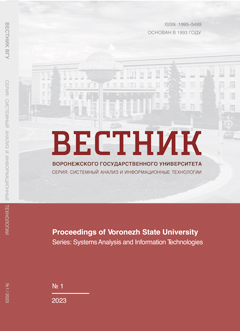Онтологическая модель формирования человеко-машинных групп
Аннотация
Целью статьи является разработка онтологической модели формирования человеко-машинных групп. Одной из проблем на этапе организации человеко-машинной группы является необходимость взаимодействия потенциальных участников группы — людей и вычислительных ресурсов — для обмена информацией о своих целях и возможностях. Онтологии позволяют представлять знания, требующиеся для формирования человеко-машинных групп, и являются общепризнанным средством поддержки взаимодействия разнородных объектов, что обусловливает актуальность цели исследований. Научная новизна заключается в интеграции в онтологическую модель видов знаний, которые выделяются в различных исследованиях как необходимые для рассмотрения при формировании человеко-машинных групп. Статья содержит обзор рассмотренных исследований, предлагает вопросы компетенции к онтологической модели формирования человеко-машинных групп, и представляет онтологическую контекстно-ориентированную модель формирования таких групп. Данная модель предлагает концепты и механизмы, требующиеся при формировании человеко-машинных групп, и позволяет организовать контекстно-ориентированное взаимодействие людей и вычислительных ресурсов с целью их присоединения к такой группе.
Скачивания
Литература
2. Klein G., Feltovich P. J., Bradshaw J. M. and Woods D. D. (2005) Common Ground and Coordination in Joint Activity. In: Organizational Simulation. Hoboken, NJ, USA, John Wiley & Sons, Inc. P. 139–184. DOI
3. Johnson M. and Bradshaw J. M. (2021) How Interdependence Explains the World of Teamwork. In: W. F. Lawless, J. Llinas, D. A. Sofge, & R. Mittu (eds.). Engineering Artificially Intelligent Systems. Lecture Notes in Computer Science. Cham, Springer. P. 122–146. DOI
4. Anon (n.d.) Merriam-Webster Online Dictionary. URL
5. Moseley C. (2020) Collaboration vs cooperation: what’s the difference? 2020. Blog entry. URL
6. Dillenbourg P. (1999) What do you mean by collaborative learning? In: P. Dillenbourg (ed.). Collaborative Learning: Cognitive and Computational Approaches. Oxford, Elsevier. P. 1–19.
7. Alhaji B., Beecken J., Ehlers R., Gertheiss J., Merz F., Müller J. P., Prilla M., Rausch A., Reinhardt A., Reinhardt D., Rembe C., Rohweder N.-O., Schwindt C., Westphal S. and Zimmermann J. (2020) Engineering Human-Machine Teams for Trusted Collaboration. Big Data and Cognitive Computing. 35 (4). P. 30. DOI
8. Mostafa S. A., Ahmad M. S. and Mustapha A. (2019) Adjustable autonomy: a systematic literature review. Artificial Intelligence Review. 51 (2). P. 149–186. DOI
9. Demartini G., Mizzaro S. and Spina D. (2020) Human-in-the-loop Artificial Intelligence for Fighting Online Misinformation: Challenges and Opportunities. The Bulletin of the Technical Committee on Data Engineering. 43 (3). P. 65–74. URL
10. Xiong W., Fan H., Ma L. and Wang C. (2022) Challenges of human-machine collaboration in risky decision-making. Frontiers of Engineering Management. 9 (1). P. 89–103. DOI
11. Stowers K., Brady L. L., MacLellan C., Wohleber R. and Salas E. (2021) Improving Teamwork Competencies in Human-Machine Teams: Perspectives From Team Science. Frontiers in Psychology. 12. DOI
12. Chen J. Y. C., Barnes M. J., Wright J. L., Stowers K. and Lakhmani S. G. (2017) Situation awareness-based agent transparency for human-autonomy teaming effectiveness. In: T. George, A. K. Dutta, & M. S. Islam (eds.). Proceedings Volume 10194, Micro- and Nanotechnology Sensors, Systems, and Applications IX. 18 May 2017 p. 101941V. DOI
13. Tellex S., Gopalan N., Kress-Gazit H. and Matuszek C. (2020) Robots That Use Language. Annual Review of Control, Robotics, and Autonomous Systems. 3 (1). P. 25–55. DOI
14. Gunning D. and Aha D. (2019) DARPA’s Explainable Artificial Intelligence (XAI) Program. AI Magazine. 40 (2). P. 44–58. DOI
15. Sanneman L. and Shah J. A. (2020) A Situation Awareness-Based Framework for Design and Evaluation of Explainable AI. In: D. Calvaresi, A. Najjar, M. Winikoff, & K. Främling (eds.). Explainable, Transparent Autonomous Agents and Multi-Agent Systems. EXTRAAMAS 2020. Lecture Notes in Computer Science. Cham, Springer. P. 94–110. DOI
16. Nam C. S. andLyons J. B. (eds.) (2020) Trust in Human-Robot Interaction. Academic Press.
17. Shively R. J., Lachter J., Brandt S. L., Matessa M., Battiste V. and Johnson W. W. (2018) Why Human-Autonomy Teaming? In: C. Baldwin (ed.). Advances in Neuroergonomics and Cognitive Engineering. AHFE 2017. Advances in Intelligent Systems and Computing. Cham, Springer. P. 3–11. DOI
18. Turkle S. (2001) Human-Computer Interface. In: N.J. Smelser & P.B. Baltes (eds.). International Encyclopedia of the Social & Behavioral Sciences. Elsevier. P. 7035–7038. DOI
19. Anon (1991) 610-1990 – IEEE Standard Computer Dictionary: A Compilation of IEEE Standard Computer Glossaries. DOI
20. Driskell J. E., Salas E. and Driskell T. (2018) Foundations of teamwork and collaboration. American Psychologist. 73 (4). P. 334–348. DOI
21. Johnson M., Bradshaw J. M., Feltovich P. J., Jonker C. M., Van Riemsdijk M. B. and Sierhuis M. (2014) Coactive Design: Designing Support for Interdependence in Joint Activity. Journal of Human-Robot Interaction. 3 (1). P. 43–69. DOI
22. Adriaensen A., Berx N., Pintelon L., Costantino F., Di Gravio G. and Patriarca R. (2022) Interdependence Analysis in collaborative robot applications from a joint cognitive functional perspective. International Journal of Industrial Ergonomics. 90, 103320. DOI
23. McDermott P., Dominguez C., Kasdaglis N., Ryan M., Trahan I. and Nelson A. (2018) Human-Machine Teaming Systems Engineering Guide. URL
24. Andrews R. W., Lilly J. M., Srivastava D. and Feigh K. M. (2022) The role of shared mental models in human-AI teams: a theoretical review. Theoretical Issues in Ergonomics Science. P. 1–47. DOI
25. Cannon-Bowers J. A., Salas E. and Converse S. (1993) Shared Mental Models in Expert Team Decision Making. In: N. J. Castellan (ed.). Individual and Group Decision Making: Current Issues. 1st edition. Psychology Press. P. 221– 246.
26. Badke-Schaub P., Neumann A., Lauche K. and Mohammed S. (2007) Mental models in design teams: a valid approach to performance in design collaboration? CoDesign. 3 (1). P. 5–20. DOI
27. Lee J.-E.R. and Nass C. I. (2010) Trust in Computers: The Computers-Are-Social-Actors (CASA) Paradigm and Trustworthiness Perception in Human-Computer Communication. In: D. Latusek & A. Gerbasi (eds.). Trust and Technology in a Ubiquitous Modern Environment:
Theoretical and Methodological Perspectives. IGI Global. P. 1–15. DOI
28. Wright J. L., Lakhmani S. G., Schwartz M. R. and Chen J. Y. (2022) Bidirectional Communications in Human-Agent Teaming: The Effect of CommunicationStyle. URL
29. Chien S.-Y., Lewis M., Sycara K., Kumru A. and Liu J.-S. (2020) Influence of Culture, Transparency, Trust, and Degree of Automation on Automation Use. IEEE Transactions on Human-Machine Systems. 50 (3). P. 205–214. DOI
30. Matthews G., Lin J., Panganiban A. R. and Long M. D. (2020) Individual Differences in Trust in Autonomous Robots: Implications for Transparency. IEEE Transactions on Human-Machine Systems. 50 (3). P. 234–244. DOI
31. Lyons J. B., Sycara K., Lewis M. and Capiola A. (2021) Human-Autonomy Teaming: Definitions, Debates, and Directions. Frontiers in Psychology. 12. DOI
32. Lyons J. B. and Havig P. R. (2014) Transparency in a Human-Machine Context: Approaches for Fostering Shared Awareness/Intent. In: R. Shumaker & S. Lackey (eds.). Virtual, Augmented and Mixed Reality. Designing and Developing Virtual and Augmented Environments. Lecture Notes in Computer Science. Cham, Springer. P. 181–190. DOI
33. Alonso F., Fuertes J. L., Martínez L. and Soza H. (2008) Measuring the Social Ability of Software Agents. In: 2008 Sixth International Conference on Software Engineering Research, Management and Applications. 2008 IEEE. P. 3–10. DOI
34. Lawless W. F., Mittu R., Sofge D. and Hiatt L. (2019) Artificial intelligence, Autonomy, and Human-Machine Teams — Interdependence, Context, and Explainable AI. AI Magazine. 40 (3). P. 5–13. DOI
35. Lawless W. F., Mittu R., Sofge D. A., Shortell T. and McDermott T. A. (2021) Introduction to “Systems Engineering and Artificial Intelligence” and the Chapters. In: Systems Engineering and Artificial Intelligence. Cham, Springer International Publishing. P. 1–22. DOI
36. Rajsiri V. (2009) Knowledge-based system for collaborative process specification. Université de Toulouse. URL
37. Gomes-Perez A., Juristo N. and Pazos J. (1995) Evaluation and assessment of knowledge sharing technology. In: N.J. Mars (ed.). Towards Very Large Knowledge Bases — Knowledge Building and Knowledge Sharing. Amsterdam, IOS Press. P. 289–296.
38. Gurianova M. A. Efimenko I. V., Khoroshevsky V. F. (2011) Ontological Modeling of Enterprises and Markets of Modern Russia: Part 2. R&Ds Worldwide: State-of-the-Art in Domain: Working paper WP7/2011/08 (part 2), Moscow : Publishing House of the Higher School of Economics, 2011. 88 p. (In Russian)
39. Suárez-Figueroa M. C., Gómez-Pérez A. and Fernández-López M. (2015) The NeOn Methodology framework: A scenario-based methodology for ontology development. Applied Ontology. 10 (2). P. 107–145. DOI
- Авторы сохраняют за собой авторские права и предоставляют журналу право первой публикации работы, которая по истечении 6 месяцев после публикации автоматически лицензируется на условиях Creative Commons Attribution License , которая позволяет другим распространять данную работу с обязательным сохранением ссылок на авторов оригинальной работы и оригинальную публикацию в этом журнале.
- Авторы имеют право размещать их работу в сети Интернет (например в институтском хранилище или персональном сайте) до и во время процесса рассмотрения ее данным журналом, так как это может привести к продуктивному обсуждению и большему количеству ссылок на данную работу (См. The Effect of Open Access).



















